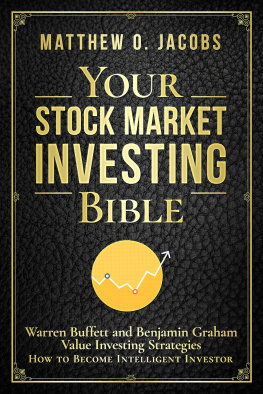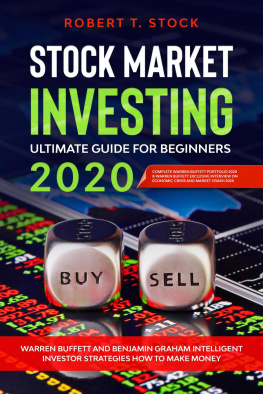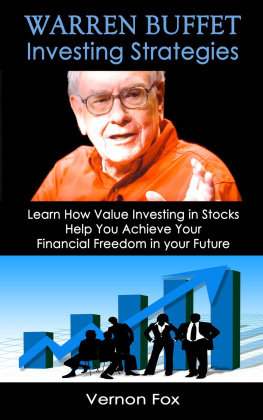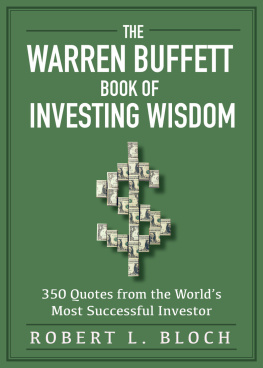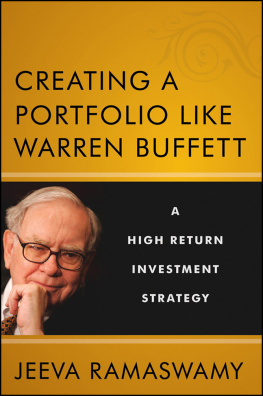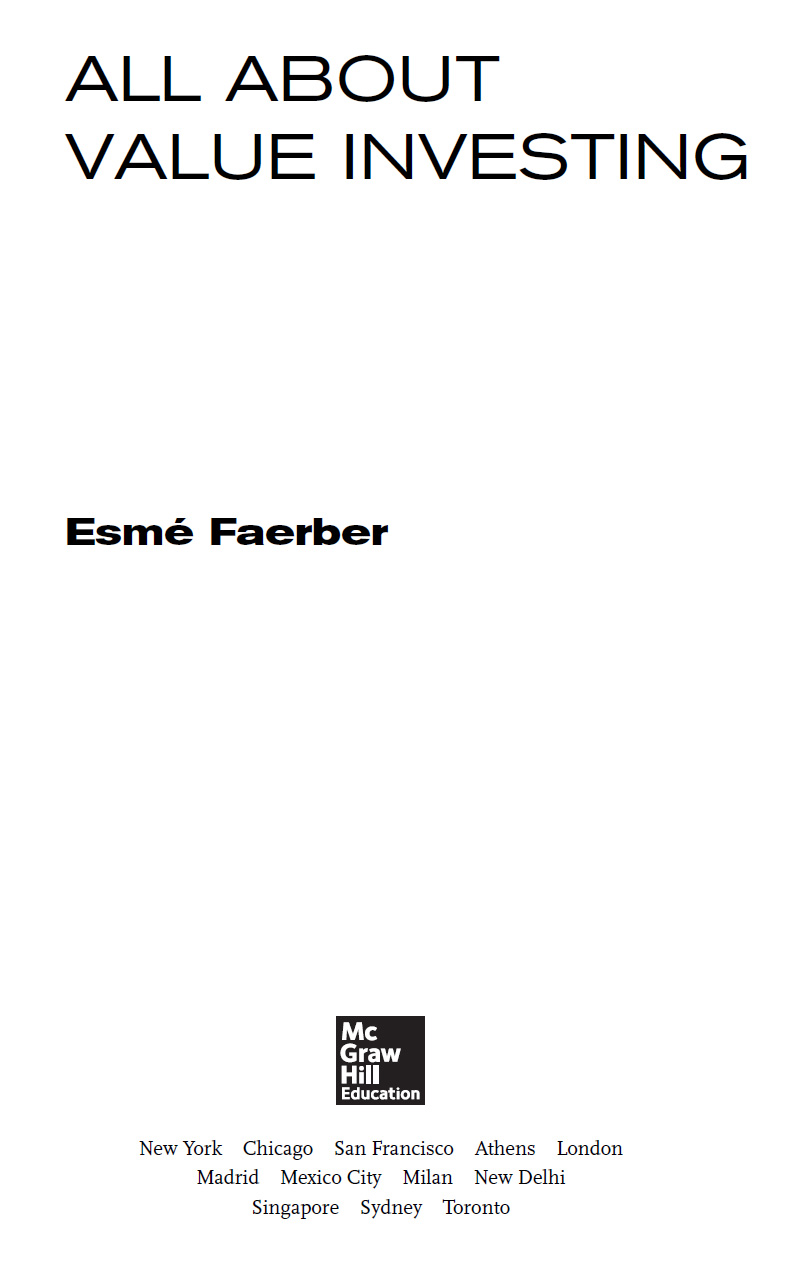Copyright 2014 by Esm Faerber. All rights reserved. Except as permitted under the United States Copyright Act of 1976, no part of this publication may be reproduced or distributed in any form or by any means, or stored in a database or retrieval system, without the prior written permission of the publisher.
ISBN: 978-0-07-181113-2
MHID: 0-07-181113-3
The material in this eBook also appears in the print version of this title: ISBN: 978-0-07-181112-5, MHID: 0-07-181112-5.
eBook conversion by codeMantra
Version 1.0
All trademarks are trademarks of their respective owners. Rather than put a trademark symbol after every occurrence of a trademarked name, we use names in an editorial fashion only, and to the benefit of the trademark owner, with no intention of infringement of the trademark. Where such designations appear in this book, they have been printed with initial caps.
McGraw-Hill Education eBooks are available at special quantity discounts to use as premiums and sales promotions, or for use in corporate training programs. To contact a representative please visit the Contact Us page at www.mhprofessional.com.
This publication is designed to provide accurate and authoritative information in regard to the subject matter covered. It is sold with the understanding that neither the author nor the publisher is engaged in rendering legal, accounting, securities trading, or other professional services. If legal advice or other expert assistance is required, the services of a competent professional person should be sought.
From a Declaration of Principles Jointly Adopted by a Committee of the American Bar Association and a Committee of Publishers and Associations
TERMS OF USE
This is a copyrighted work and McGraw-Hill Education and its licensors reserve all rights in and to the work. Use of this work is subject to these terms. Except as permitted under the Copyright Act of 1976 and the right to store and retrieve one copy of the work, you may not decompile, disassemble, reverse engineer, reproduce, modify, create derivative works based upon, transmit, distribute, disseminate, sell, publish or sublicense the work or any part of it without McGraw-Hill Educations prior consent. You may use the work for your own noncommercial and personal use; any other use of the work is strictly prohibited. Your right to use the work may be terminated if you fail to comply with these terms.
THE WORK IS PROVIDED AS IS. McGRAW-HILL EDUCATION AND ITS LICENSORS MAKE NO GUARANTEES OR WARRANTIES AS TO THE ACCURACY, ADEQUACY OR COMPLETENESS OF OR RESULTS TO BE OBTAINED FROM USING THE WORK, INCLUDING ANY INFORMATION THAT CAN BE ACCESSED THROUGH THE WORK VIA HYPERLINK OR OTHERWISE, AND EXPRESSLY DISCLAIM ANY WARRANTY, EXPRESS OR IMPLIED, INCLUDING BUT NOT LIMITED TO IMPLIED WARRANTIES OF MERCHANTABILITY OR FITNESS FOR A PARTICULAR PURPOSE. McGraw-Hill Education and its licensors do not warrant or guarantee that the functions contained in the work will meet your requirements or that its operation will be uninterrupted or error free. Neither McGraw-Hill Education nor its licensors shall be liable to you or anyone else for any inaccuracy, error or omission, regardless of cause, in the work or for any damages resulting therefrom. McGraw-Hill Education has no responsibility for the content of any information accessed through the work. Under no circumstances shall McGraw-Hill Education and/or its licensors be liable for any indirect, incidental, special, punitive, consequential or similar damages that result from the use of or inability to use the work, even if any of them has been advised of the possibility of such damages. This limitation of liability shall apply to any claim or cause whatsoever whether such claim or cause arises in contract, tort or otherwise.
CONTENTS
PREFACE
Buy and youll be sorry,
Sell and youll regret.
Hold and youll worry,
Do nothing and youll fret.
The traders lament
The traders lament epitomizes the agonies that every investor experiences when making investment decisions. The insight provided by the traders lament is that hindsight always produces the best results with 20-20 vision. Without clairvoyance into the future, however, investors are open to making investment mistakes. The aim of this book is to reduce the typical investment mistakes made. It is not possible to always be 100 percent correct in the investment decisions made, but knowing when investments are cheap and when they are expensive will decrease the error rate made by investors. Value investing is finding stocks that are trading at bargain prices and then selling them when they have risen in value to their fair or intrinsic values. This could mean waiting a long time, holding these stocks before they are recognized by the majority of investors.
This book illustrates the different value investment styles. Deep value investors look for undervalued stocks that have been temporarily beaten down for one reason or another, but the companies have strong balance sheets and competitive advantages that will restore the stocks value over time. Not all value investors are deep value investors. Growth stocks can come down in price as a result of circumstances and may present value at their lowered prices. Similarly, value investors could look for dividend yielding stocks that present value. If you believe that the business environment is not going to grow significantly, then value stocks that provide dividend yields are the answer. If on the other hand you believe that the economy is geared to growth, then growth stocks are the answer.
This book illustrates the different investment styles. After reading this book, investors should have a better idea of the value investment style that they feel comfortable with in assembling their investment portfolios.
Esm Faerber
CHAPTER 1
Value Investing: What It Is and What It Is Not
There are two sides to every security transaction: a buyer of the security and a seller of the security. So it would seem that one of the two parties must be wrong. Not necessarily; one or both parties could make a profit, depending on the circumstances and the time. On the one hand, either the security has reached a price at which the seller thinks it will not rise any more or at which the seller wants to exit to realize an amount of profit. On the other hand, the buyer of the security thinks the security will rise in price and provide future profit. Consequently, both the buyer and the seller could realize profits over time.
Where or how does the value investor fit in this example? The value investor looks at the underlying aspects of the security to determine whether its price undervalues or overvalues the business to grow its future earnings (profits). The value investor buys the security when the price is less than the underlying value of the business and sells the security when the price is greater than the underlying value of the business.
Value investing can then be defined as looking for companies with strong fundamentals (good earnings, a strong cash flow) that are trading at bargain prices. Value investing is looking for businesses that are incorrectly valued by the market and can increase in value when the market recognizes that mistaken valuation. The astute reader will immediately question the contradiction of this previous statement, which is also negated by the efficient market hypothesis.
EFFICIENT MARKET HYPOTHESIS
The efficient market hypothesis contends that stocks are always fairly valued, trading at their intrinsic values. According to the efficient market theory, information about companies is conveyed quickly and efficiently by the market, resulting in no underpriced stocks. In other words, when a stock is underpriced, investors will buy the stock, sending it up to its fair value, and when a stock is overpriced, it is sold by holders until it reaches its fair or intrinsic value. Consequently, there are no or very few undervalued or overvalued stocks.


